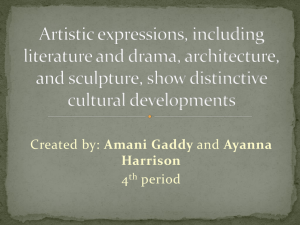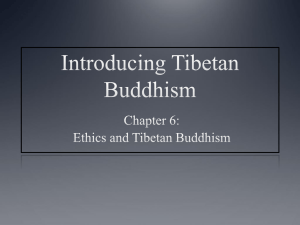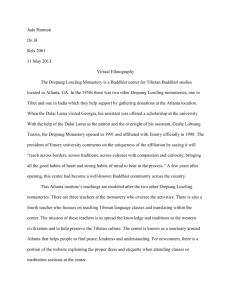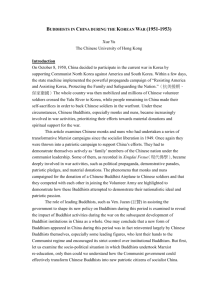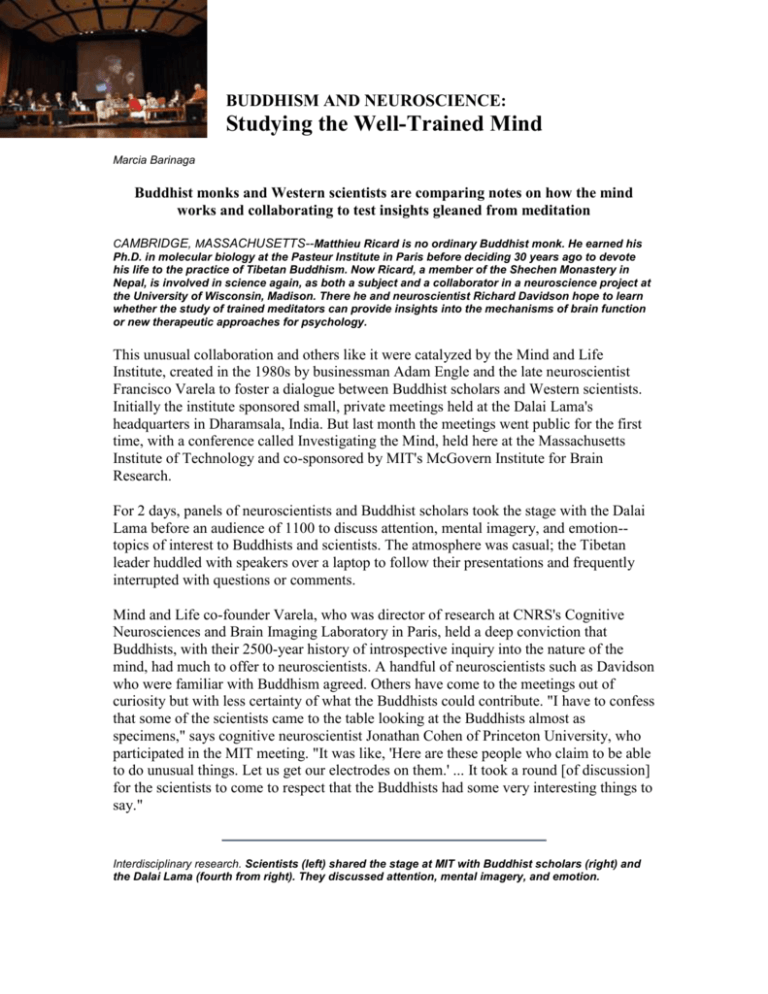
BUDDHISM AND NEUROSCIENCE:
Studying the Well-Trained Mind
Marcia Barinaga
Buddhist monks and Western scientists are comparing notes on how the mind
works and collaborating to test insights gleaned from meditation
CAMBRIDGE, MASSACHUSETTS--Matthieu Ricard is no ordinary Buddhist monk. He earned his
Ph.D. in molecular biology at the Pasteur Institute in Paris before deciding 30 years ago to devote
his life to the practice of Tibetan Buddhism. Now Ricard, a member of the Shechen Monastery in
Nepal, is involved in science again, as both a subject and a collaborator in a neuroscience project at
the University of Wisconsin, Madison. There he and neuroscientist Richard Davidson hope to learn
whether the study of trained meditators can provide insights into the mechanisms of brain function
or new therapeutic approaches for psychology.
This unusual collaboration and others like it were catalyzed by the Mind and Life
Institute, created in the 1980s by businessman Adam Engle and the late neuroscientist
Francisco Varela to foster a dialogue between Buddhist scholars and Western scientists.
Initially the institute sponsored small, private meetings held at the Dalai Lama's
headquarters in Dharamsala, India. But last month the meetings went public for the first
time, with a conference called Investigating the Mind, held here at the Massachusetts
Institute of Technology and co-sponsored by MIT's McGovern Institute for Brain
Research.
For 2 days, panels of neuroscientists and Buddhist scholars took the stage with the Dalai
Lama before an audience of 1100 to discuss attention, mental imagery, and emotion-topics of interest to Buddhists and scientists. The atmosphere was casual; the Tibetan
leader huddled with speakers over a laptop to follow their presentations and frequently
interrupted with questions or comments.
Mind and Life co-founder Varela, who was director of research at CNRS's Cognitive
Neurosciences and Brain Imaging Laboratory in Paris, held a deep conviction that
Buddhists, with their 2500-year history of introspective inquiry into the nature of the
mind, had much to offer to neuroscientists. A handful of neuroscientists such as Davidson
who were familiar with Buddhism agreed. Others have come to the meetings out of
curiosity but with less certainty of what the Buddhists could contribute. "I have to confess
that some of the scientists came to the table looking at the Buddhists almost as
specimens," says cognitive neuroscientist Jonathan Cohen of Princeton University, who
participated in the MIT meeting. "It was like, 'Here are these people who claim to be able
to do unusual things. Let us get our electrodes on them.' ... It took a round [of discussion]
for the scientists to come to respect that the Buddhists had some very interesting things to
say."
Interdisciplinary research. Scientists (left) shared the stage at MIT with Buddhist scholars (right) and
the Dalai Lama (fourth from right). They discussed attention, mental imagery, and emotion.
CREDIT: DONNA COVENEY/MIT
A Buddhist science of the mind
Some scientists made that transition through learning more about meditation. The
practice is often viewed by Westerners as merely a form of relaxation whose benefits are
limited to stress relief or lowered blood pressure. It is actually a rigorous system of mind
training and observation of mental processes, what Buddhists consider to be their own
"science of the mind." "From its outset, [Buddhism] has had a very strong emphasis on
refining the attention, enhancing attention skills, and developing very sophisticated
means for investigating the nature of the mind from a first-person perspective," says
Buddhist scholar and former monk B. Alan Wallace, president of the Santa Barbara
Institute for the Interdisciplinary Study of Consciousness.
What's more, Wallace adds, the Buddha himself told his followers not to take his
teachings on faith but to test them for themselves. That spirit of inquiry makes some
Buddhist practitioners eager to participate in neuroscience studies.
The time is ripe for Buddhists' input, says Clifford Saron, a researcher at the Center for
Mind and Brain at the University of California (UC), Davis. The tools with which
cognitive neuroscientists measure brain activity have grown so sensitive, Saron says, that
scientists can observe differences in brain activity between individuals doing the same
task or even between different trials with the same individual. There is information in that
variation, but it requires the input of the subject to decipher it. "Most people have very
little training to report how they did a task," Saron says, but meditators who are trained to
observe their own minds should be able to describe in detail whether their attention was
more stable in one trial versus another, whether they prepared themselves in a slightly
different way, or even what kinds of fleeting emotions or images might have passed
through their mind.
Buddhists say they hope the interaction will lead to several things--first of all, "a healthier
world," according to Buddhist monk and meeting participant Ajahn Amaro of the
Abhayagiri Monastery in Redwood Valley, California. Beyond that, they want the
opportunity to test their first-person insights with Western research techniques and
understand better the mental states they achieve through meditation. There has been a fair
amount of "shlock science" done toward this end, Davidson says, but the Mind and Life
Institute has approached the issue "in a very different way, involving the very best people
in their respective areas," he adds.
One hot topic at the MIT meeting was the role of introspection, or reporting personal
mental experience, in science. Although introspection has formed the basis of the
Buddhist investigation of the mind, Harvard University psychologist Daniel Gilbert notes
that "a lot of scientists have a hard time getting their heads around the idea that
introspection can be a form of data." Indeed, Harvard psychologist Stephen Kosslyn
spent part of his presentation illustrating ways in which subjects' reports on the mental
strategy they used to solve a problem could be misleading.
Despite such caveats, neuroscience has already begun using first-person insights
to help frame questions, says neuroscientist G. Ron Mangun, director of UC
Davis's Center for Mind and Brain. "When you are talking about something like
human cognition, if you don't use introspection to guide you, it is a bit difficult to
get anywhere," Mangun says. "We use introspection all the time in our research.
We are just trained to be very careful with how we use it."
Dialogue. Stephen Kosslyn explains a psychological test to the Dalai Lama.
CREDIT: DONNA COVENEY/MIT
Some Buddhists' introspections directly challenge views held by neuroscientists. For
instance, trained meditators claim to be able to hold their attention on a single object for
hours, or to shift attention rapidly as many as 17 times in the span of a finger-snap. These
claims contradict Western reports that attention cannot be held that long or switched that
fast. Whether such claims prove to be precisely true or not, MIT neuroscientist Nancy
Kanwisher is eager to see whether monks who have spent years training their attention
are better on standard attention tests than the average person. "Training the attention has
barely been touched by cognitive neuroscience," says Kanwisher.
Soon that may change. UC Davis's Mangun and Saron are planning a collaboration with
the Santa Barbara Institute's Wallace to test the attention skills of trained meditators.
They plan to enroll two dozen volunteers in a 3-month, intensive, full-time program in
shamatha, a form of Buddhist contemplative training that is aimed at enhancing attention
skills. In exchange for the training, the meditators will agree to be subjects for
psychological and brain-imaging studies of attention.
Because subjects will be tested before, during, and after their training, the study avoids
certain pitfalls of working with established meditators, such as the possibility that any
observed differences might reflect not training but the fact that subjects drawn to
meditation may have had unusual brains to begin with.
Hold that image
Whereas some Buddhist practitioners specialize in attention, others devote themselves to
the demanding practice of visual imagery, meditating on an image held in the mind as a
means to purge the mind of value judgments. It may take decades for a monk to develop
prowess in imagery. Some virtuosos claim to be able to hold in their minds a detailed
image such as a complex mandala, a symbolic depiction of the universe, for many
minutes or even hours.
These claims are also contradicted by Western neuroscience. "Based on my
understanding of how the brain works, that should not be possible," says Harvard's
Kosslyn, who studies mental imagery. Kosslyn has found that mental images are fleeting-necessarily so, he reasons, because mental imagery uses the same brain areas that serve
vision, and visual images fade quickly from the brain to prevent the
appearance of smearing as our eyes move.
"Do you have plans to conduct experiments on monks?" the Dalai
Lama asked Kosslyn. "If they are different, how will it change your
theory?" Kosslyn replied that he is eager to test his theory with trained meditators, and he
has already set up experiments to test the holding of an image over time, and the
vividness of images. If he were to find differences with trained meditators, he said, he
would scan their brains for unusual activity that might explain the disparity, using
functional magnetic resonance imaging.
There is an impediment to doing such experiments: Very few monks are truly
accomplished in visual imagery, and, says Ricard, "they are contemplative hermits. None
of them is ready to come to the lab." Ricard says he hopes to find some moderately
accomplished monks who are willing to travel.
Collaborators. Richard Davidson (left) and Matthieu Ricard after a brain-imaging experiment.
CREDIT: R. DAVIDSON/W. M. KECK LABORATORY FOR FUNCTIONAL BRAIN IMAGING AND BEHAVIOR, UNIV. OF
WISCONSIN
Accentuate the positive
The collaboration between Buddhists and neuroscientists has borne the most fruit to date
in the study of emotions. Buddhist meditation fosters "virtuous" mental states that are
said to promote well-being, such as compassion, joy, and "loving-kindness." UC
Berkeley psychologist Dacher Keltner says this is a radically different approach from
Western psychology, which focuses mainly on negative mental states such as anger, fear,
or depression.
A growing number of Western psychologists are investigating the potential of Buddhist
meditation training to shift the brain into positive emotional states. Wisconsin's Davidson
is collaborating with Ricard to study the brain activity associated with positive emotions
in Buddhist monks. Davidson and his colleagues have demonstrated repeatedly that
activity in the frontal region of the brain reflects a person's emotional state. A high ratio
of activity in the left versus the right frontal areas marks either a fleeting positive mood
or what Davidson calls a positive "affective style," which is the quality of mood that
persists over time. Subjects gripped in a negative mood, or with generally negative
affective styles, rank lower on the left-to-right ratio. And when researchers trigger a
negative emotion, for example by showing subjects a disturbing news photo, those
negative emotions fade more quickly in people with more left-frontal brain activity.
Using such techniques, Davidson and postdoc Antoine Lutz are studying Ricard and
other monks with many years of meditation experience. Their first subject, while not
meditating, showed a left-right brain activity ratio higher than that of any of the 150 non-
Buddhist subjects the team had previously tested. The team has tested six monks so far.
The data are still being analyzed, but Davidson reported at the MIT meeting that when
the monks were instructed to meditate on compassion, they showed a greater shift toward
left-frontal activation than control subjects who were not trained meditators but who were
given instructions to meditate on compassion.
Such a study can't rule out the possibility that the monks' brains were unusual even before
they began their training. So Davidson's team took another approach. It recruited
employees of Promega, a Madison-based biotech company, to go through 8 weeks of
basic meditation training. Volunteers were randomly assigned to receive the training or
not. The team recently reported in Psychosomatic Medicine that, compared with controls,
those trained to meditate showed an increase in left-prefrontal activation both at rest and
in response to an emotional challenge.
"This was not in any shape or form a definitive study," says Davidson. But it is not the
only pilot project to have produced tantalizing preliminary results. A study called the
Cultivating Emotional Balance project has also suggested that meditation training can
promote emotional health in Westerners. UC San Francisco psychologist Paul Ekman
conceived of the project after participating in one of the Mind and Life meetings in
Dharamsala and developed it with Wallace and UCSF health psychologist Margaret
Kemeny. For the pilot study, 15 school teachers underwent a 5-week intensive course in
meditation that includes meditation on compassion and loving-kindness, integrated with
strategies and techniques selected from modern Western emotion research.
The teachers performed a battery of psychological tests before and after the training.
They were wired for physiological measures such as heart rate and blood pressure, and
they were videotaped so that psychologists could monitor them for nonverbal reactions
that show feelings such as contempt or acceptance. The subjects showed more positive
emotional responses after training than before. Based on that result, the researchers are
planning a larger study--this time with a control group.
Kemeny notes that the Cultivating Emotional Balance project differs from other studies
in that the focus of its training is on emotions such as compassion and empathy that
generate a positive feeling toward others, and in its measurement of changes in the
subjects' reactions to other people. "We want to understand the psychological effects" of
such training, she says.
That is a question for which the Dalai Lama has a ready answer. In his closing remarks,
he repeated his faith in the power of science and encouraged collaboration between
Buddhists and scientists, ending with a confident exhortation to his audience to
"encourage positive emotions, discourage negative. Then you will be more happy." If the
Buddhists and neuroscientists can put their heads together and figure out how we can all
do that, maybe Ajahn Amaro will get his wish for a healthier world.
Summary of this Article
PDF Version of this
Article
Download to Citation
Manager
Alert me when:
new articles cite this article
Search for similar
articles in:
Science Online
PubMed
Search Medline for
articles by:
Barinaga, M.
This article appears in
the following Subject
Collections:
Neuroscience
Volume 302, Number 5642, Issue of 3 Oct 2003, pp. 44-46.
Copyright © 2003 by The American Association for the Advancement of Science. All rights reserved.



